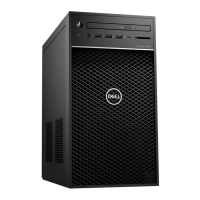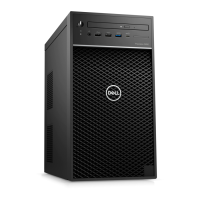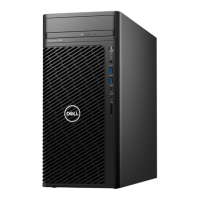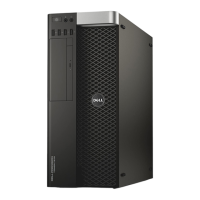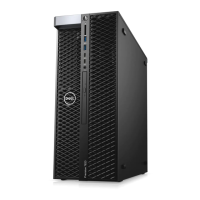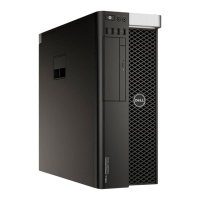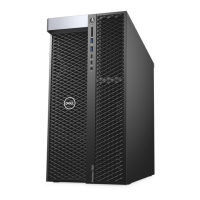Do you have a question about the Dell Precision Tower 3620 and is the answer not in the manual?
Essential safety guidelines for using and servicing your computer to prevent damage.
Steps to take before working inside the computer, including powering off.
Steps to reconnect devices and verify computer functionality after internal work.
List of tools required for component removal and installation procedures.
Steps for removing and installing the computer cover.
Steps for removing and installing the front bezel.
Steps for removing and installing the hard drive assembly.
Steps for removing and installing the optical drive.
Steps for removing and installing the intrusion switch.
Steps for removing and installing memory modules.
Steps for installing the PCIe Solid State Drive (SSD).
Steps for removing the PCIe Solid State Drive (SSD).
Steps for removing and installing the power supply unit.
Steps for removing and installing the Input/Output (I/O) panel.
Steps for removing and installing the system speaker.
Steps for removing and installing expansion cards.
Steps for removing and installing the system fan.
Steps for removing and installing the heat sink assembly.
Steps for removing and installing the processor.
Steps for removing and installing the system board.
Options for configuring the system's boot device order.
Explanation of keys used for navigating within the System Setup utility.
View primary hardware features and configuration details of the computer.
Settings for Integrated NIC, Serial Port, SATA Operation, and Drives.
Settings for advanced boot options and system date/time configuration.
Options for managing passwords, TPM, Computrace, and chassis intrusion.
Settings for processor performance, power management, and wake-up features.
Procedures for updating the BIOS and configuring jumper settings.
Creating, changing, and disabling system and setup passwords.
How to run the Enhanced Pre-Boot System Assessment for hardware testing.
Information on troubleshooting using power LED diagnostics, beep codes, and error messages.
Details on processor types, cache, and memory configurations.
Specifications for integrated graphics, audio, and network capabilities.
Details on system chipset, DMA channels, BIOS, and expansion bus types.
Specifications for internal/external drives and various connectors.
Information on power ratings, physical dimensions, and controls/lights.
Operating and storage conditions including temperature, humidity, vibration, and shock.
How to find contact information and access online/telephone support from Dell.
Essential safety guidelines for using and servicing your computer to prevent damage.
Steps to take before working inside the computer, including powering off.
Steps to reconnect devices and verify computer functionality after internal work.
List of tools required for component removal and installation procedures.
Steps for removing and installing the computer cover.
Steps for removing and installing the front bezel.
Steps for removing and installing the hard drive assembly.
Steps for removing and installing the optical drive.
Steps for removing and installing the intrusion switch.
Steps for removing and installing memory modules.
Steps for installing the PCIe Solid State Drive (SSD).
Steps for removing the PCIe Solid State Drive (SSD).
Steps for removing and installing the power supply unit.
Steps for removing and installing the Input/Output (I/O) panel.
Steps for removing and installing the system speaker.
Steps for removing and installing expansion cards.
Steps for removing and installing the system fan.
Steps for removing and installing the heat sink assembly.
Steps for removing and installing the processor.
Steps for removing and installing the system board.
Options for configuring the system's boot device order.
Explanation of keys used for navigating within the System Setup utility.
View primary hardware features and configuration details of the computer.
Settings for Integrated NIC, Serial Port, SATA Operation, and Drives.
Settings for advanced boot options and system date/time configuration.
Options for managing passwords, TPM, Computrace, and chassis intrusion.
Settings for processor performance, power management, and wake-up features.
Procedures for updating the BIOS and configuring jumper settings.
Creating, changing, and disabling system and setup passwords.
How to run the Enhanced Pre-Boot System Assessment for hardware testing.
Information on troubleshooting using power LED diagnostics, beep codes, and error messages.
Details on processor types, cache, and memory configurations.
Specifications for integrated graphics, audio, and network capabilities.
Details on system chipset, DMA channels, BIOS, and expansion bus types.
Specifications for internal/external drives and various connectors.
Information on power ratings, physical dimensions, and controls/lights.
Operating and storage conditions including temperature, humidity, vibration, and shock.
How to find contact information and access online/telephone support from Dell.
| Tcase | 71 °C |
|---|---|
| Bus type | DMI3 |
| Stepping | R0 |
| Tjunction | - °C |
| FSB Parity | No |
| Processor cache | 6 MB |
| Processor cores | 4 |
| Processor model | i5-6500 |
| System bus rate | 8 GT/s |
| Processor family | Intel® Core™ i5 |
| Processor series | Intel Core i5-6500 Desktop series |
| Processor socket | LGA 1151 (Socket H4) |
| Processor codename | Skylake |
| Number of QPI links | - |
| Processor frequency | 3.2 GHz |
| Processor cache type | Smart Cache |
| Configurable TDP-down | - W |
| Processor lithography | 14 nm |
| Processor manufacturer | Intel |
| Processor front side bus | - MHz |
| PCI Express slots version | 3.0 |
| Processor boost frequency | 3.6 GHz |
| Processor operating modes | 64-bit |
| PCI Express configurations | 1x16, 2x8, 1x8+2x4 |
| Thermal Design Power (TDP) | 65 W |
| Number of processors installed | 1 |
| Maximum number of PCI Express lanes | 16 |
| Memory types supported by processor | DDR3L-SDRAM, DDR4-SDRAM |
| Memory voltage supported by processor | 1.35 V |
| Memory clock speeds supported by processor | 2133, 1333, 1600, 1866 MHz |
| Memory bandwidth supported by processor (max) | 34.1 GB/s |
| Maximum internal memory supported by processor | 64 GB |
| On-board graphics card ID | 1912 |
| Discrete graphics card model | Not available |
| On-board graphics card model | Intel® HD Graphics 530 |
| Graphics card Open GL support | Yes |
| On-board graphics card family | Intel® HD Graphics |
| Maximum on-board graphics card memory | 1.74 GB |
| On-board graphics card OpenGL version | 4.4 |
| On-board graphics card base frequency | 350 MHz |
| On-board graphics card DirectX version | 12.0 |
| On-board graphics card dynamic frequency (max) | 1050 MHz |
| Number of displays supported (on-board graphics) | 3 |
| Scalability | 1S |
| Processor code | SR2BX |
| Processor ARK ID | 88184 |
| Processor package size | 37.5 x 37.5 mm |
| Supported instruction sets | SSE4.2, AVX 2.0, SSE4.1 |
| Thermal solution specification | PCG 2015C |
| Intel Stable Image Platform Program (SIPP) version | 1.00 |
| Optical drives quantity | 0 |
| Intel® Virtualization Technology (Intel® VT) | VT-x, VT-d |
| Memory slots | 4x DIMM |
| Internal memory | 8 GB |
| Memory channels | Dual-channel |
| Memory clock speed | 2133 MHz |
| Internal memory type | DDR4-SDRAM |
| Memory layout (slots x size) | 2 x 4 GB |
| HDD size | 3.5 \ |
| HDD speed | 7200 RPM |
| HDD interface | SATA III |
| Storage media | HDD |
| Total storage capacity | 500 GB |
| Operating system installed | Windows 7 Professional |
| Cabling technology | 10/100/1000Base-T(X) |
| Ethernet LAN data rates | 10, 100, 1000 Mbit/s |
| USB 2.0 ports quantity | USB 2.0 ports have a data transmission speed of 480 Mbps, and are backwards compatible with USB 1.1 ports. You can connect all kinds of peripheral devices to them. |
| USB 3.2 Gen 1 (3.1 Gen 1) Type-A ports quantity | 6 |
| Chassis type | Mini Tower |
| Product color | Black |
| Placement supported | Horizontal/Vertical |
| Audio system | HD |
| Product type | Workstation |
| Motherboard chipset | Intel® C236 |
| Power supply | 290 W |
| Power supply input voltage | 100 - 240 V |
| Power supply input frequency | 50 - 60 Hz |
| Operating altitude | -15.2 - 3048 m |
| Non-operating altitude | -15.2 - 10668 m |
| Storage temperature (T-T) | -40 - 65 °C |
| Operating temperature (T-T) | 5 - 35 °C |
| Storage relative humidity (H-H) | 5 - 95 % |
| Operating relative humidity (H-H) | 20 - 80 % |
| Depth | 434.8 mm |
|---|---|
| Width | 175 mm |
| Height | 359.9 mm |
| Weight | 9100 g |

